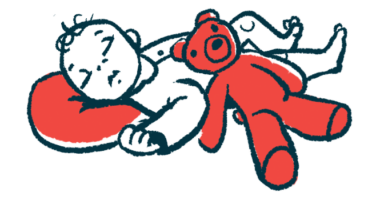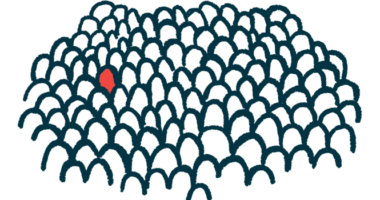From basic training to treatment: An 8-year Pompe diagnosis journey
A columnist kicks off 'The Pompe Community Diaries' with Michael Thames' story

In this column, I’m introducing what I call “The Pompe Community Diaries,” a series that will follow the journeys, musings, and challenges of the fellow Pompe disease patient community. I’ll collaborate with community members to share their voices and day-to-day experiences over time. It’s a space meant to foster bonding within our rare community of diverse stories, wherever the road may take us.
In his early 20s, Michael Thames enlisted in the U.S. Air Force Reserve as a hydraulic specialist on the C-17 Globemaster III aircraft. Michael didn’t know it at the time, but he had Pompe disease, a degenerative genetic disorder characterized by missing enzymes that are necessary to break down glycogen. A buildup of sugars in tissues causes increasing muscle damage.
As with any military career, Michael had to graduate basic training first. At the start, he was at the minimum weight requirement, meaning he couldn’t lose any more weight. Worried that he would, Michael abstained from physical training beforehand.
The first eight weeks of basic training would be anything but easy, as they entailed calisthenics, running, marching, and “rucking” around with a heavy pack and a rifle. Michael also had to pull fire guard multiple times a week. On those nights, he’d get only five hours of sleep after training during the daytime.
An average training day started at 5 a.m. Physical training was the first activity, lasting a minimum of an hour. Everywhere he went, Michael had to march — whether it was outdoors in the Texas summer heat or to the rifle range or tear gas chamber, or to the classroom to learn military history and the rules of combat. He donned a full uniform, boots, a weighted backpack, and a rifle. Unfortunately, he also had to do supplemental physical training to catch up, which meant twice-daily workouts on top of everything else.
Basic training dramatically improved his pace. He eked out the bare minimum number of pushups and situps, but it meant he could graduate basic training and move on to the next stage: technical school and nine weeks focused on aircraft mechanics.
Academically, Michael graduated as the honor graduate in his class, missing only six questions over eight exams. But without the focus on physical training, his physical scores were declining.
When he arrived at his duty station in Charleston, South Carolina, he had to take a physical training test. He wasn’t surprised when he came up short on all three metrics of the test. This was the start of his ongoing adventure to figure out what was going on with him physically. He was eating right, sleeping fine, working out, and taking care of himself. Someone his age shouldn’t have been declining so rapidly.
Michael served out his six-year contract, and most of the time, he worked alongside active-duty airmen and women. He worked on jets and performed his primary duties. However, continuing declines in his physical training score prompted his program therapist to send him to specialists. Yet all of the test results were normal. As a last resort, he was sent to a neurologist, who gave him the dreaded news that he might have a muscle disorder.
After a misdiagnosis, answers finally come
After multiple tests, he was diagnosed with limb-girdle muscular dystrophy (LGMD). This was the nail in the coffin for Michael’s military career, as neurological conditions like this are immediately disqualifying.
Every few months, Michael would Google LGMD to see if there had been any advancements in medical research. One night, after he’d been Googling for eight years, he encountered a lead: A lab was conducting free genetic testing. He followed up, and when the results came back, life began to move quickly.
Michael was sent to another neurologist, who then sent him to a geneticist at the Greenwood Genetic Center in South Carolina. As he was driving there, he remained hopeful for some positive news, but he was also skeptical, as his journey to that point had been nothing but bad news.
A young geneticist walked in and dropped a bomb: “We’re 99% sure you don’t have limb-girdle,” the geneticist said. “It’s Pompe disease, and it has a treatment.”
Michael became emotional, as this was the first time in almost a decade he had received answers. He’d already lost lots of muscle, and daily activities like getting up off the floor, bending over, and walking quickly had become activities of the past. He began treatment shortly after. It was a life-changing experience for him physically and mentally.
Today, at 37, Michael takes his Pompe diet, exercise, and infusion treatments seriously. He has since regained the ability to stand up off the floor without difficulty, can bend over to complete chores, and walks at least 8,000 steps every day. A proper diagnosis and treatment changed Michael’s outlook on life and allowed him to regain control of what he had deemed so out of control for nearly a decade.
Today, he enjoys walking his dachshund with his wife. He loves to race cars around the Carolina Motorsports Park. And he plays basketball and frisbee with his two kids.
Note: Pompe Disease News is strictly a news and information website about the disease. It does not provide medical advice, diagnosis, or treatment. This content is not intended to be a substitute for professional medical advice, diagnosis, or treatment. Always seek the advice of your physician or other qualified health provider with any questions you may have regarding a medical condition. Never disregard professional medical advice or delay in seeking it because of something you have read on this website. The opinions expressed in this column are not those of Pompe Disease News or its parent company, Bionews, and are intended to spark discussion about issues pertaining to Pompe disease.








Leave a comment
Fill in the required fields to post. Your email address will not be published.